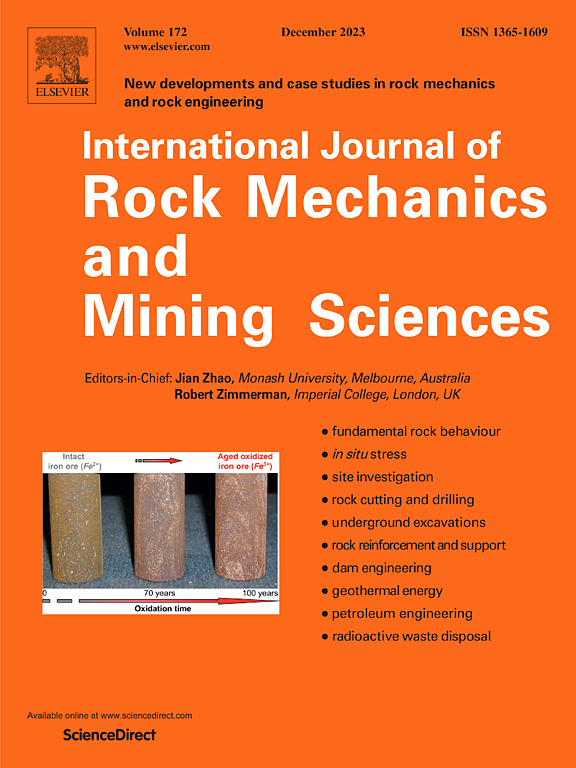Systematic investigation of stress-induced fracture closure and permeability evolution in Lac du Bonnet granite
IF 7
1区 工程技术
Q1 ENGINEERING, GEOLOGICAL
International Journal of Rock Mechanics and Mining Sciences
Pub Date : 2025-04-14
DOI:10.1016/j.ijrmms.2025.106113
引用次数: 0
Abstract
Fracture permeability is influenced by the mechanical properties of geomaterials, surface geometry, aperture distribution, and stress conditions. However, accurately characterizing fracture surfaces and aperture distributions, along with their effects on permeability under stress remains challenging. This study systematically investigates the evolution of fracture permeability and closure behavior in Lac du Bonnet granite through integrated steady-state flow experiments, high-resolution laser scanning, and 3D numerical modelling. A 3D digital twin model of the fractured sample was developed to quantify key geometric characteristics of fracture surfaces, including surface gradient, height deviation, mean curvature, Gaussian curvature, and spatial distribution of peaks and valleys. These metrics were used to evaluate their influence on fracture openness. Fracture closure measurements were incorporated as boundary conditions in the numerical model to assess the evolution of the aperture field under varying stress levels. Statistical analysis of the computed aperture fields and corresponding fluid activity was conducted to provide insights into heterogeneous fracture closure behavior. The results reveal that fracture permeability follows a quadratic exponential decline under confining stress of 5–40 MPa, leading to an overall reduction of 82.1 %, while fracture aperture decreases exponentially by 60.4 %. Permeability hysteresis was observed after stress relief, indicating significant impact of stress exposure history on fluid flow behavior. Throughout the experiments, hydraulic aperture variations closely aligned with mechanical aperture measurements, validating the applicability of the cubic law. Based on these experiment results, empirical models describing permeability-stress and mechanical-hydraulic aperture relationships were established, and a modification to the cubic law was proposed. The proposed statistical aperture distribution analysis provides a novel approach for quantifying heterogeneous fracture closure, while the modified cubic law, based on the mechanical-hydraulic aperture relationship, enhances rapid predictions of fracture permeability under varying stress levels.
Lac du Bonnet花岗岩应力致裂缝闭合及渗透率演化系统研究
裂缝渗透率受岩土材料力学性能、表面几何形状、孔径分布和应力条件的影响。然而,准确表征裂缝表面和孔径分布,以及它们在应力作用下对渗透率的影响仍然具有挑战性。本研究通过综合稳态流动实验、高分辨率激光扫描和三维数值模拟,系统地研究了Lac du Bonnet花岗岩裂缝渗透率和闭合行为的演化。开发了裂缝样品的三维数字孪生模型,以量化裂缝表面的关键几何特征,包括表面梯度、高度偏差、平均曲率、高斯曲率以及峰谷的空间分布。这些指标被用来评估它们对骨折开放性的影响。数值模型将裂缝闭合测量作为边界条件,以评估不同应力水平下孔径场的演化。对计算的孔径场和相应的流体活动性进行统计分析,以深入了解非均质裂缝闭合行为。结果表明:围应力为5 ~ 40 MPa时,裂缝渗透率呈二次指数递减,总体减小82.1%,裂缝孔径呈指数递减60.4%;应力消除后,渗透率出现了滞后现象,表明应力暴露历史对流体流动行为有显著影响。在整个实验中,水力孔径变化与机械孔径测量结果密切相关,验证了三次定律的适用性。基于这些实验结果,建立了描述渗透-应力和机械-水力孔径关系的经验模型,并提出了对三次定律的修正。提出的统计孔径分布分析方法为非均质裂缝闭合提供了一种新的量化方法,而基于力学-水力孔径关系的修正三次定律则增强了对不同应力水平下裂缝渗透率的快速预测。
本文章由计算机程序翻译,如有差异,请以英文原文为准。
求助全文
约1分钟内获得全文
求助全文
来源期刊
CiteScore
14.00
自引率
5.60%
发文量
196
审稿时长
18 weeks
期刊介绍:
The International Journal of Rock Mechanics and Mining Sciences focuses on original research, new developments, site measurements, and case studies within the fields of rock mechanics and rock engineering. Serving as an international platform, it showcases high-quality papers addressing rock mechanics and the application of its principles and techniques in mining and civil engineering projects situated on or within rock masses. These projects encompass a wide range, including slopes, open-pit mines, quarries, shafts, tunnels, caverns, underground mines, metro systems, dams, hydro-electric stations, geothermal energy, petroleum engineering, and radioactive waste disposal. The journal welcomes submissions on various topics, with particular interest in theoretical advancements, analytical and numerical methods, rock testing, site investigation, and case studies.

 求助内容:
求助内容: 应助结果提醒方式:
应助结果提醒方式:


